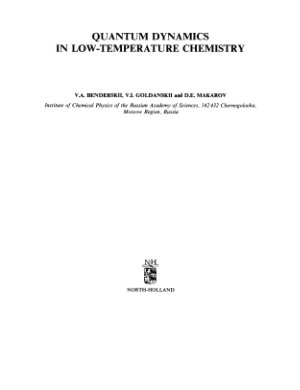PHYSICS REPORTS (Review Section of Physics Letters) 233, Nos. 4 & 5
(1993) 195-339
A contemporary review of quantum models of chemical reactions is presented. At low temperatures tunneling prevails over thermally activated transitions and results in non-Arrhenius behavior of the rate constant, which cannot be described in terms of classical transition state theory and requires explicit incorporation of environment dynamics. The correlation between the quantum rate constant and spectral properties of the heat bath and dynamics of intramolecular vibrations is considered. The spectroscopic evidence of tunneling in molecules is also discussed. The theoretical consideration is illustrated by a number of experimental examples.
Contents
Introduction
Historical background
Routes of simplifying the problem
From thermal activation to tunneling
Cross-over temperature
Tunneling and dissipation
Coherent versus incoherent tunneling
Vibronic relaxation and electron transfer
Vibration-assisted tunneling
Is there an alteative to tunneling?
One-dimensional models
The main path-integral relations
Decay of metastable state
The Im F method
Tunneling splitting in a double well
Nonadiabatic tunneling
Quantum transition state theory
Two-dimensional tunneling
Decay of metastable state
Tunneling splitting
Periodic orbits in symmetric double well
Chemical dynamics in the presence of a heat bath
Quasienergy method
Bath of harmonic oscillators
Dynamics of the dissipative two-level system
Dissipative nonadiabatic tunneling
Examples of quantum chemical reactions
Hydrogen transfer
Tunneling rotation of methyl group
Tunneling in molecular dimers
Tunneling of heavy particles
Summary and perspectives
Appendix A Derivation of eqs B) and B)
Appendix B Dissipative nonadiabatic tunneling at T = 0
References
A contemporary review of quantum models of chemical reactions is presented. At low temperatures tunneling prevails over thermally activated transitions and results in non-Arrhenius behavior of the rate constant, which cannot be described in terms of classical transition state theory and requires explicit incorporation of environment dynamics. The correlation between the quantum rate constant and spectral properties of the heat bath and dynamics of intramolecular vibrations is considered. The spectroscopic evidence of tunneling in molecules is also discussed. The theoretical consideration is illustrated by a number of experimental examples.
Contents
Introduction
Historical background
Routes of simplifying the problem
From thermal activation to tunneling
Cross-over temperature
Tunneling and dissipation
Coherent versus incoherent tunneling
Vibronic relaxation and electron transfer
Vibration-assisted tunneling
Is there an alteative to tunneling?
One-dimensional models
The main path-integral relations
Decay of metastable state
The Im F method
Tunneling splitting in a double well
Nonadiabatic tunneling
Quantum transition state theory
Two-dimensional tunneling
Decay of metastable state
Tunneling splitting
Periodic orbits in symmetric double well
Chemical dynamics in the presence of a heat bath
Quasienergy method
Bath of harmonic oscillators
Dynamics of the dissipative two-level system
Dissipative nonadiabatic tunneling
Examples of quantum chemical reactions
Hydrogen transfer
Tunneling rotation of methyl group
Tunneling in molecular dimers
Tunneling of heavy particles
Summary and perspectives
Appendix A Derivation of eqs B) and B)
Appendix B Dissipative nonadiabatic tunneling at T = 0
References

